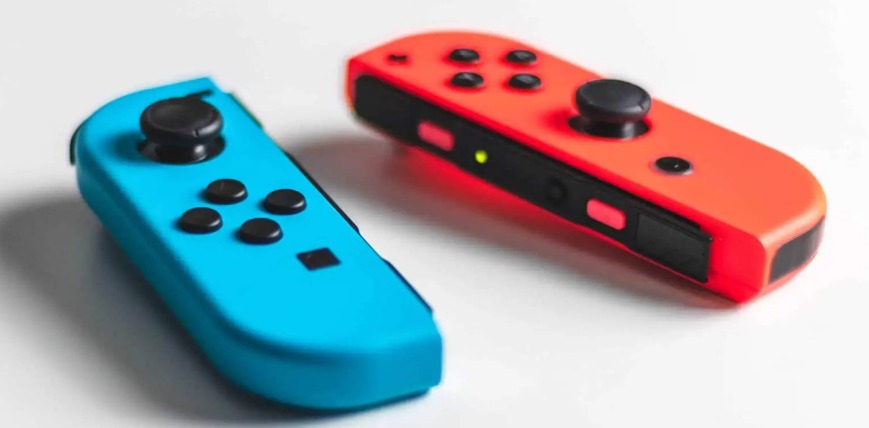Pairing Joy Cons to a Mac is easy, but getting them to work as a combined controller is another issue. However, the effort might be worth it, especially if you don’t want to spend money on a new controller.
Here is how to use Joy Cons on a Mac as a combined controller:
- Connect the Joy Cons to your mac.
- Use the JoyKeyMapper App to pair your Joy Cons.
- Try the Joystick Mapper app if JoyKeyMapper fails.
- Download a button mapper and virtual controller.
This process shouldn’t take too long if you do it properly, but there are a few common pitfalls. Besides, if JoyKeyMapper doesn’t work for you, you’ll need to try a different app. This article will get you ready for any issue.
1. Connect the Joy Cons to Your Mac
Connecting Joy Cons to a Mac is extremely easy. At first, this caught many people by surprise since it’s not the kind of feature Nintendo normally offers.
Using two Joy Cons as a single, combined controller is more complicated. Once you connect a Joy Con to your Mac, there are no options to change any of its settings without the help of extra software.
Before we go over options to achieve that, let’s go over a few steps that are common to every method. The first thing you have to do is connect your Joy Cons to your Mac via Bluetooth.
- Put your Joy Con in syncing mode. Press and hold the Sync button on one of your Joy Cons until green lights start flashing up and down. Do the same thing with your other Joy Con.
- Open your Bluetooth preferences. You can do this by clicking on the Bluetooth icon on the upper right part of your screen and selecting “Bluetooth preferences.” If you don’t see the icon, go to System Preferences, click on “Dock & Menu Bar,” select the “Bluetooth” tab, and check the box that says “Show in Menu Bar.”
- Pair your Joy Cons. After opening your Bluetooth preferences, you should see both Joy-Cons on the Devices panel. Select one and click “Pair.”
Now you’re done! This procedure also works with Pro Controllers without any changes, so if you have one, feel free to connect it as well.
If you’d like a more hands-on explanation, you can watch this video by EasyOSX:
And in case you’re curious, you can also connect Xbox One and Playstation 5 controllers using the same method.
After connecting a Joy Con to your Mac, you’ll be able to use it in most games without any extra settings as a single controller. So, if you’re fine with only using one JoyCon, just go ahead and play!
But if you’re here, it’s because you want the full package. Let’s go over a few options that will let you use your Joy Cons as dual controllers.
2. Use the JoyKeyMapper App To Pair Your Joy Cons
This is one of the few pieces of software that let you use your Joy Cons as a pair. However, it does much more than that.
JoyKeyMapper is an app that lets you map your controller to your keyboard or mouse. And it works across all apps, not just games (although you’re probably not going to use your JoyCons in Photoshop).
This app also supports the Switch Pro Controller. And, for the retro gamers, the latest update introduced support for NES and SNES controllers.
The only drawback of JoyKeyMapper is that it only works on Intel-based Macs. Luckily, there is a solution for owners with Apple silicon.
JoyMapperSilicon is a slightly modified version of JoyKeyMapper that supports Macs with Apple microchips. It also works with Intel-based Macs.
However, JoyMapperSilicon also adds a couple of handy improvements. For one, it allows you to map the joystick on the Joy Con to your mouse inside games. This allows you to play games that don’t recognize your controllers.
JoyMapperSilicon also lets you enable joystick orientation at 45 degrees, which makes characters move more smoothly.
JoyMapperSilicon is probably the better option, but if it isn’t working well or you’re having compatibility issues, try with the original JoyKeyMapper. Also, JoyKeyMapper can be downloaded from the AppStore, while JoyMapperSillicon is only available through GitHub.
Follow these steps to pair your Joy Cons using the JoyKeyMapper app:
1. Download and Install JoyKeyMapper
You can download JoyKeyMapper from the AppStore or its GitHub page. For JoyMapperSilicon, visit the GitHub page.
To download from GitHub, go to the app’s page and click on the “Releases” panel on the right of the screen. You’ll be directed to the latest release. Unless you want to get under the hood of the program, download the .dmg file. In the case of JoyMapperSillicon, it’s a .zip file.
Now it’s time to install. If you downloaded JoyKeyMapper from the AppStore, then it’s ready to use.
If you downloaded JoyKeyMapper from GitHub, open the .dmg file you downloaded. Once opened, drag the icon called JoyKeyMapper.app to your Applications folder. It should be working correctly now.
For JoyMapperSilicon it’s the same process, but you’ll have to uncompress the .zip file first.
2. Add Your Games (Optional)
After opening JoyKeyMapper or JoyMapperSilicon, you’ll see a panel on the left called Apps.
Here you can assign different profiles to specific apps. This can be very useful since different games will work better with different layouts.
To add an App to the list, click the “+” sign at the bottom left and select the desired app.
However, for most games, the default profile should be enough. If you want something different, you can also make changes to the default setting instead of setting one up from scratch.
3. Create a Profile for Each Joy Con
You should see both Joy Cons displayed on the upper panel named “Controllers.” Keep in mind that you can only configure them if they are connected to your Mac at that moment.
Now comes the most important part: assigning a key or mouse event to each of your Joy Cons’ buttons. Let’s see how that works.
4. Map Each Joy Con’s Buttons to Your Mouse and Keyboard
To map a button, simply click on it and press the desired key or mouse button. The program will allow you to choose between keys and mouse movement for the left and right sticks.
Games won’t recognize your Joy Cons as a controller, and they will still work with keyboard inputs. What JoyKeyMapper does is let you control those keyboard inputs with your Joy Cons. The result is, in most cases, just as good.
Sadly, it’s not possible to map Joy Con’s gyroscope to any key.
5. Try Your Joy Cons in a Game
If you did everything correctly, your Joy Cons should now control their assigned keys and mouse buttons. If you created a preset for a specific app, the button mapping will only work in that app. If you use the default preset, it should work everywhere.
Now it’s time to put it to the test. Open a game and see if it works!
Remember that the game is still reading your inputs as keyboard and mouse. Make sure all key bindings inside the game correspond to the key bindings you assigned to your Joy Cons.
This method might not work with every game. However, many people have had success with it.
For example, user Qibin Chen managed to play The Witcher 3 with dual Joy Cons without any issue:
If this method doesn’t work for you or you would like a more versatile app, take a look at the next step:
3. Try the Joystick Mapper App if JoyKeyMapper Fails
Joystick Mapper works similarly to JoyKeyMapper. It lets you map your Joy Con’s buttons to any key or mouse event and use it in games.
The first difference you’ll notice between the two is that Joystick Mapper costs $5 and is only downloadable from the Appstore, whereas JoyKeyMapper is free and open source.
The main feature that you’re getting for the price is the ability to sync any Mac-compatible gamepad, not just Switch controllers. If you have other controllers that you can’t reliably use in your games, Joystick Mapper will have you covered.
Joystick Mapper is designed to be as generic as possible, so it will work with pretty much any gamepad. Users regularly use it for Xbox 360, PS3, and Logitech controllers.
Joystick Mapper also has a different interface that some users might find more intuitive.
Ultimately, both apps should work just fine. If you want something versatile and easy to use, you can buy a Joystick Mapper. If you don’t feel like spending the money and only need an app for a few specific cases, just go with JoyKeyMapper or JoyMapperSilicon.
Here’s how you can pair your Joy Cons using Joystick Mapper:
- Download and Install Joystick Mapper. To download and install Joystick Mapper, visit its App Store page.
- Create a preset for your Joy Cons. After opening the app, you will see two windows. The main screen shows you a list of previously used configurations. The second screen lets you choose the inputs and buttons for each configuration.
- Click on “Add New Preset.” A new window should open, where you will click “Add New Joystick.” Since you’re going to use both Joy Cons, add both of them. You can add them both now or finish mapping one of them and then go back and add the other one.
- Bind Your Joy Con buttons. To map the buttons in your Joy Cons, click on “Add new bind.” First, you’ll select the input. Click on “scan” and then press the desired button on your controller. You can also select it from a list.
- Select the output. In the column to the right of the blue arrow, select the kind of output you want. You can choose from keyboard key, mouse click, mouse motion, or mouse wheel.
- In the next column, select the specific output. This can be a key or a mouse command.
- Activate the preset. For a preset to work, it has to be active. Simply connect the gamepad in question and hit the checkbox at the left of the preset on the main screen.
- Try your Joy Cons in a game. All that’s left is go ahead and try your Joy Cons in a game.
This app has a relatively active user base, so you can expect more updates and plenty of help from other users. If you find yourself having a specific technical issue, chances are someone else has gone through the same.
4. Download a Button Mapper and Virtual Controller
Here’s an extra step for advanced users. Since there are a lot of variables here, let’s keep it short.
So far, we’ve seen how to control your keyboard and mouse with Joy Cons, but it’s possible to have the games to see them as an actual controller. However, it will require some tinkering.
- Download a button mapper. You can choose between JoyKeyMapper and Joystick mapper. Other similar programs may also work.
- Download and install required drivers if necessary. For example, if you’re going to emulate an Xbox360 controller and use it in games, you’ll need to install the proper drivers. Some controllers don’t need extra drivers.
- Download and install a virtual controller emulator. You need a program that can create a virtual controller that your Mac can recognize as one. Enjoyable is a popular choice. You can also try ControllerMate.
- Create a virtual controller. The process varies from program to program. The objective is to create an instance of an emulated controller that your Mac will treat as a real one. Different controller emulators might only work with specific button mappers. Try out combinations until you find one that works.
- Map your Joy Cons to your virtual controller. Once your emulated controller is up and running, go to JoyKeyMapper (or Joystick Mapper, depending on which one works better for you).
Now, if everything is working well, you’ll be able to map each Joy Con’s buttons to the buttons on the virtual controller (you’ll probably need the help of the controller emulator app).
Alternatively, you can also map the Joy Cons to your keyboard and mouse and set your virtual controller to those outputs.
In any case, this isn’t a straightforward solution that may not work with every game. But if you’re tech-savvy and are up to play around with these programs, you might get some cool results.
Final Thoughts
There’s no obvious way to use your Joy Cons as a combined controller, but you can do it with a bit of tinkering and extra software.
Both JoyKeyMapper and Joystick Mapper are capable of doing this. They are easy to install and use, and mapping each Joy Con’s buttons to your mouse and keyboard should only take a few minutes.
If you want to get into more advanced territory, you can pair that up with a virtual controller emulator.







